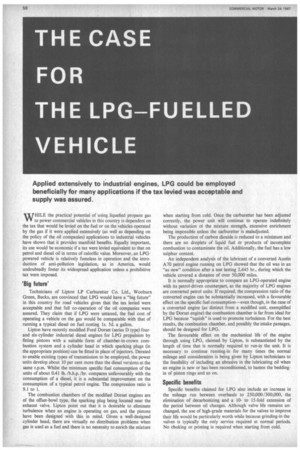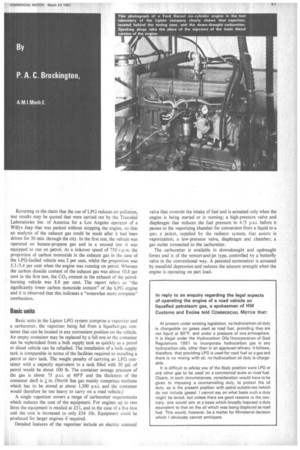THE CASE FOR THE LPG-FUELLED VEHICLE
Page 58

Page 59

If you've noticed an error in this article please click here to report it so we can fix it.
Applied extensively to industrial engines. LPG could be employed beneficially for many applications if the tax levied was acceptable and supply was assured.
WHILE the practical potential of using liquefied propane gas to power commercial vehicles in this country is dependent on the tax that would be levied on the fuel or on the vehicles operated by the gas if it were applied extensively (as well as depending on the policy of the oil companies) applications to industrial vehicles have shown that it provides manifold benefits. Equally important, its use would be economic if a tax were levied equivalent to that on petrol and diesel oil in terms of calorific value. Moreover, an LPGpowered vehicle is relatively fumeless in operation and the introduction of anti-pollution legislation, as in America, would undoubtedly foster its widespread application unless a prohibitive tax were imposed.
'Big future'
Technicians of Lipton LP Carburetter Co. Ltd., Wooburn Green, Bucks, are convinced that LPG would have a "big future" in this country for road vehicles given that the tax levied were acceptable and that full co-operation of the oil companies were assured. They claim that if LPG were untaxed, the fuel cost of operating a vehicle on the gas would be comparable with that of running a typical diesel on fuel costing ls. 5d. a gallon.
Lipton have recently modified Ford Dorset (series D type) fourand six-cylinder industrial diesel engines for LPG propulsion by fitting pistons with a suitable form of chamber-in-crown combustion system and a cylinder head in which sparking plugs (in the appropriate position) can be fitted in place of injectors. Derated to enable existing types of transmission to be employed, the power units develop about 10 per cent more than the diesel versions at the same r.p.m. Whilst the minimum specific fuel consumption of the units of about 0.41 lb. /b.h.p. /hr. compares unfavourably with the consumption of a diesel, it is a substantial improvement on the consumption of a typical petrol engine. The compression ratio is 9.1 to 1.
The combustion chambers of the modified Dorset engines are of the offset-bowl type, the sparking plug being located near the exhaust valve. Lipton point out that it is desirable to eliminate turbulence when an engine is operating on gas, and the pistons have been designed with this in mind. Given a well-designed cylinder head, there are virtually no distribution problems when gas is used as a fuel and there is no necessity to enrich the mixture when starting from cold. Once the carburetter has been adjusted correctly, the power unit will continue to operate indefinitely without variation of the mixture . strength, excessive enrichment being impossible unless the carburetter is maladjusted.
The production of carbon dioxide is reduced to a minimum and there are no droplets of liquid fuel or products of incomplete combustion to contaminate the oil. Additionally, the fuel has a low sulphur content.
An independent analysis of the lubricant of a converted Austin A70 petrol engine running on LPG showed that the oil was in an "as new" condition after a test lasting 2,445 hr., during which the vehicle covered a distance of over 50,000 miles.
It is normally appropriate to compare an LPG-operated engine with its petrol-driven counterpart, as the majority of LPG engines are converted petrol units. If required, the compression ratio of the converted engine can be substantially increased, with a favourable effect on the specific fuel consumption—even though, in the case of a converted engine (as distinct from a modified unit, exemplified by the Dorset engine) the combustion chamber is far from ideal for LPG because "squish" is used to promote turbulence. For the best results, the combustion chamber, and possibly the intake passages, should be designed for LPG.
The favourable effect on the mechanical life of the engine through using LPG, claimed by Lipton, is substantiated by the length of time that is normally required to run-in the unit. It is necessary to continue running-in for many times the normal mileage and consideration is being given by Lipton technicians to the feasibility of including an abrasive in the lubricating oil when an engine is new or has been reconditioned, to hasten the beddingin of piston rings and so on.
Specific benefits
Specific benefits claimed for LPG also include an increase in the mileage run between overhauls to 250,000/300,000, the elimination of decarbonizing and a 10to 15-fold extension of the period between oil changes. Although valve life remains unchanged, the use of high-grade materials for the valves to improve their life would be particularly worth while because grinding-in the valves is typically the only service required at normal periods. No choking or priming is required when starting from cold.
Reverting to the claim that the use of LPG reduces air pollution, test results may be quoted that were carried out by the Truesdail Laboratories Inc. of America for a Los Angeles operator of a Willys Jeep that was parked without stopping the engine, so that an analysis of the exhaust gas could be made after it had been driven for 30 min. through the city. In the first test, the vehicle was operated on butane-propane gas and in a second test it was equipped to run on petrol. At a tickover speed of 750 r.p.m. the proportion of carbon monoxide in the exhaust gas in the case of the LPG-fuelled vehicle was 2 per cent, whilst the proportion was 5.3 /5.4 per cent when the engine was running on petrol. Whereas the carbon dioxide content of the exhaust gas was about 10.8 per cent in the first test, the CO2 content in the exhaust of the petrolburning vehicle was 8.8 per cent. The report refers to "the significantly lower carbon monoxide content" of the LPG engine and it is observed that this indicates a "somewhat more complete" combustion.
Basic units
Basic units in the Lipton LPG system comprise a vaporizer and a carburetter, the vaporizer, being fed from a liquefied-gas container that can be located in any convenient position on the vehicle. An empty container may be replaced by a full one or the container can be replenished from a bulk supply tank as quickly as a petrol or diesel vehicle can be refuelled. The installation of a bulk supply tank is comparable in terms of the facilities required to installing a petrol or dery tank. The weight penalty of carrying an LPG container with a capacity equivalent to a tank filled with 30 gal. of petrol would be about 100 lb. The container storage pressure of the gas is about 75 p.s.i. at 60°F and the thickness of the container shell is in. (North Sea gas mainly comprises methane which has to be stored at about 1,300 p.s.i. and the container would therefore be too heavy to carry on a road vehicle.) A single vaporizer covers a range of carburetter requirements which reduces the cost of the equipment. For engines up to two litres the equipment is retailed at £51, and in the case of a five-litre unit the cost is increased to only £54 10s. Equipment could be produced for larger engines if required.
Detailed features of the vaporizer include an electric solenoid valve that controls the intake of fuel and is actuated only when the engine is being started or is running; a high-pressure valve and diaphragm that reduces, the fuel pressure to 4/5 p.s.i. before it passes to the vaporizing chamber for conversion from a liquid to a gas; a jacket, supplied by the radiator system, that assists in vaporization; a low-pressure valve, diaphragm and chamber; a gas outlet connected to the carburetter.
The carburetter is available in clowndraught and updraught forms and is of the venturi-and-jet type, controlled by a butterfly valve in the conventional way. A patented economizer is actuated by manifold depression and reduces the mixture strength when the engine is operating on part load.








































































































